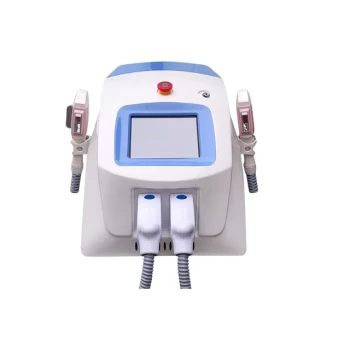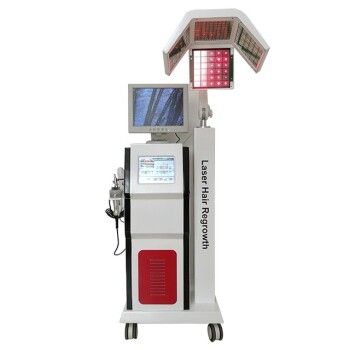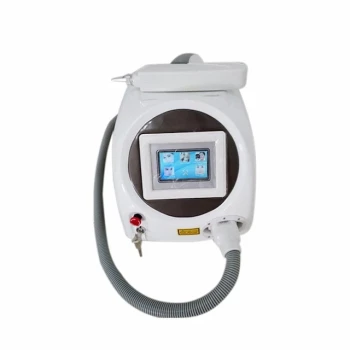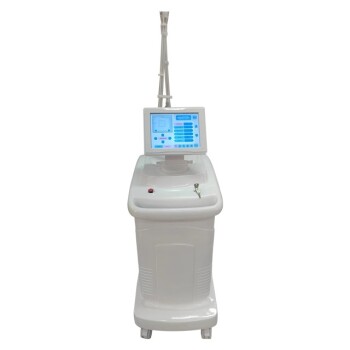In short, diode laser hair removal is a highly effective and FDA-cleared method for achieving significant, long-term hair reduction. Its success is grounded in a precise scientific principle, which means its effectiveness is not universal but is predictable and exceptionally high for the right candidates.
The core principle is straightforward: the laser energy targets the dark pigment (melanin) within the hair follicle. Therefore, the effectiveness of any treatment hinges on the contrast between your skin and hair color—the greater the contrast, the more efficient and safer the procedure.
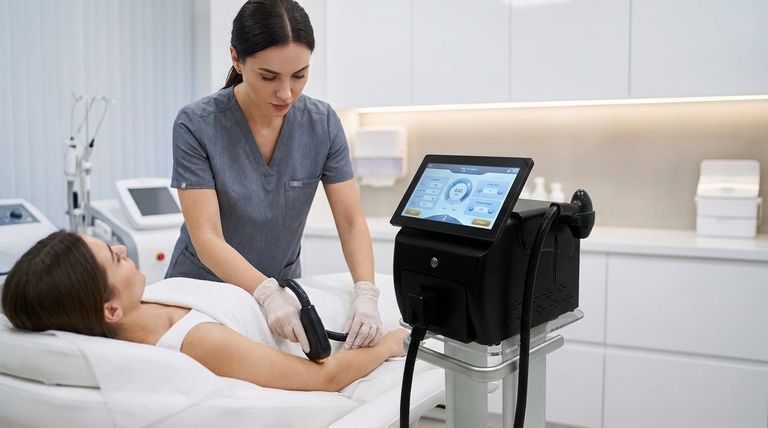
How Diode Lasers Achieve Hair Reduction
To understand its effectiveness, you must first understand the mechanism. The process isn't just about "zapping" hair; it's about systematically disabling the follicle's ability to produce it.
The Principle of Selective Photothermolysis
Diode lasers operate on a principle called selective photothermolysis. This means the laser emits a specific wavelength of light that is preferentially absorbed by the melanin (pigment) in your hair shaft.
This absorbed light energy converts into heat, which travels down the hair to the follicle. The heat then damages the key structures responsible for hair growth, dramatically inhibiting their ability to produce new hair in the future.
Targeting the Anagen Growth Phase
Your hair is not always actively growing. It cycles through three phases: anagen (growth), catagen (transition), and telogen (resting).
Laser hair removal is only effective when the hair is in the anagen phase, as this is the only time the hair is physically connected to the base of the follicle. Damaging this connection is the key to success.
Why Multiple Sessions Are Required
At any given moment, only about 10-20% of your body hair is in the anagen phase. This is the fundamental reason why a single session will not clear an area.
A full course of treatment requires multiple sessions, typically spaced 4-8 weeks apart. This schedule is designed to target new hairs as they cycle into the anagen growth phase, ensuring a progressively higher percentage of follicles are successfully treated over time.
Understanding the Ideal Candidate
Effectiveness is not a single score; it's a spectrum that depends entirely on your unique combination of skin and hair.
The Critical Role of Melanin Contrast
The ideal scenario for a diode laser is high contrast: dark, coarse hair against fair to light skin.
In this case, the laser energy is strongly absorbed by the dark hair follicle while being largely ignored by the light, low-melanin skin. This allows for powerful, effective treatment with a very low risk of side effects.
Effectiveness on Different Skin Tones
Modern diode lasers have advanced significantly. They feature adjustable settings and longer pulse durations, which allow for safer treatment on a broader range of skin tones, including olive and light brown skin.
However, as skin tone darkens, the laser has a harder time differentiating between the melanin in the skin and the melanin in the hair. This increases the risk of side effects if not performed by a skilled technician.
Ineffectiveness on Certain Hair Colors
Diode lasers are ineffective on hair that lacks sufficient melanin.
This includes white, grey, light blond, and most red hair. Without a dark pigment to absorb the laser's energy, the treatment simply cannot work.
Understanding the Trade-offs and Considerations
Objectivity requires acknowledging the limitations and potential downsides. This is not a perfect solution for everyone.
It's Hair Reduction, Not Permanent Removal
The FDA has cleared laser treatments for "permanent hair reduction," not "permanent hair removal." This is a crucial distinction.
An effective treatment course results in a significant and lasting decrease in the number and thickness of hairs. However, it may not eliminate 100% of hair forever. Hormonal changes or future life stages can sometimes stimulate new, finer hair growth that may require occasional maintenance sessions.
Potential for Discomfort and Side Effects
The sensation is often described as a quick "rubber band snap" against the skin. Most modern diode lasers include a cooling tip to dramatically improve patient comfort.
Common and temporary side effects include redness and slight swelling around the treated follicles, which typically subsides within a few hours. More serious side effects like burns or pigment changes are rare but can occur, almost always due to operator error or incorrect settings for the patient's skin type.
The Importance of Practitioner Skill
The device is only a tool; the effectiveness and safety of your treatment are overwhelmingly dependent on the skill of the practitioner.
An experienced technician will accurately assess your skin and hair type (using scales like the Fitzpatrick scale), perform a patch test, and select the precise settings to maximize results while ensuring your safety.
Making the Right Choice for Your Goal
To determine if a diode laser is the right choice, evaluate your personal characteristics against the technology's core function.
- If your primary focus is treating dark hair on fair to light skin: You are the ideal candidate for diode laser treatment and can expect highly effective, long-lasting results.
- If you have a medium to dark skin tone with dark hair: The treatment can be effective, but it is critical to find an experienced provider with a modern laser designed for your skin type to ensure both safety and efficacy.
- If your goal is to remove blond, grey, white, or red hair: A diode laser will be ineffective, and you should invest your time and resources in exploring alternative methods like electrolysis.
Understanding how this technology works is the first step toward making a confident and informed decision for your body.
Summary Table:
| Factor | Impact on Effectiveness |
|---|---|
| Skin & Hair Contrast | Highest effectiveness for dark hair on light skin. |
| Hair Color | Effective on dark hair; ineffective on white, grey, or light blond hair. |
| Growth Phase (Anagen) | Treatment only works on actively growing hairs (10-20% at any time). |
| Number of Sessions | Multiple sessions (typically 6-8) are required for optimal results. |
| Practitioner Skill | A skilled technician is crucial for safety and maximizing effectiveness. |
Ready to offer safe, effective, and long-lasting hair removal results to your clients?
BELIS specializes in providing professional medical aesthetic equipment, including advanced diode laser systems. We serve medical aesthetics clinics and premium beauty salons, helping them enhance their service offerings and grow their business.
Contact our experts today to find the perfect diode laser solution for your practice and learn how we can support your success.
Visual Guide
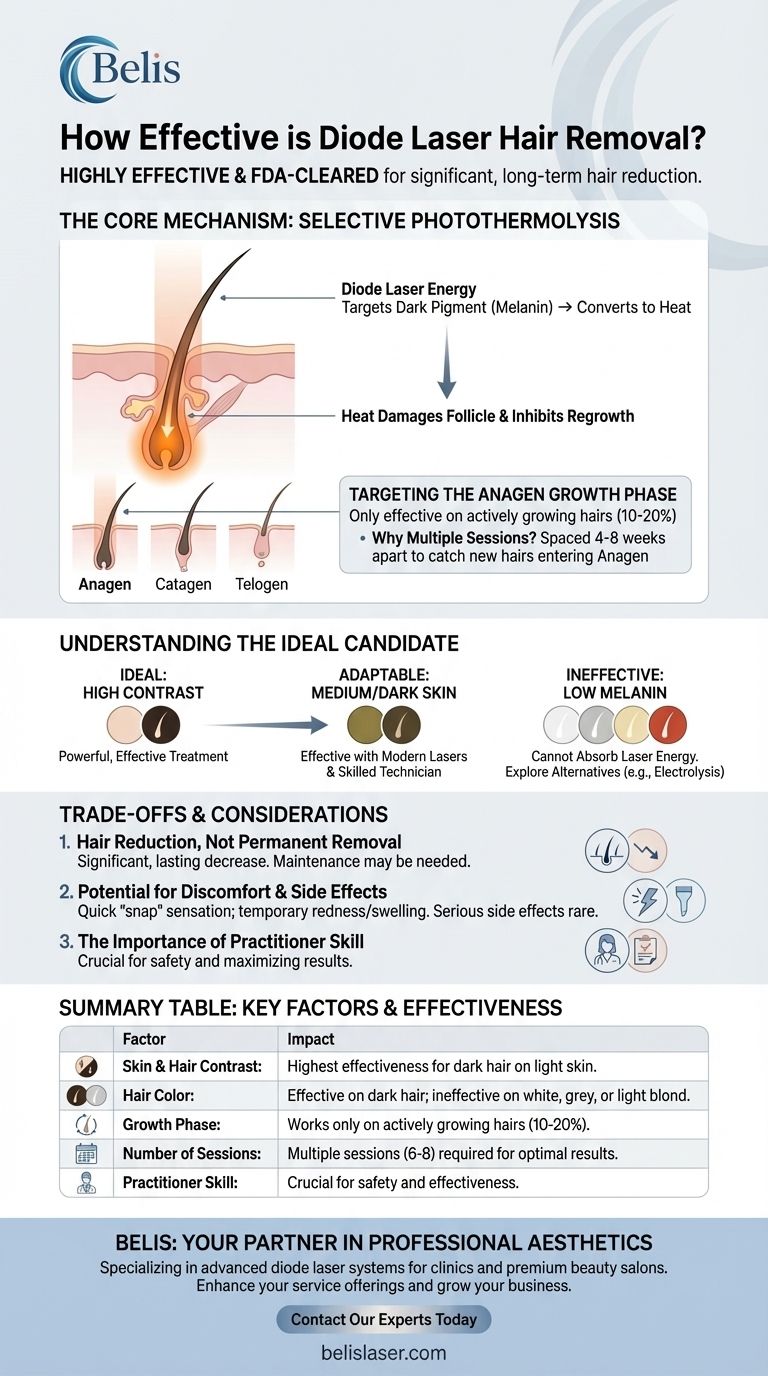
Related Products
- Trilaser Diode Hair Removal Machine for Beauty Clinic Use
- Diode Laser SHR Trilaser Hair Removal Machine for Clinic Use
- Diode Tri Laser Hair Removal Machine for Clinic Use
- Clinic Diode Laser Hair Removal Machine with SHR and Trilaser Technology
- Clinic Use IPL and SHR Hair Removal Machine with Nd Yag Laser Tattoo Removal
People Also Ask
- Who is not suitable for laser hair removal? A Safety Guide to Assess Your Candidacy
- Does laser hair removal destroy stem cells? The Key to Permanent Hair Reduction
- Is it safe to do laser every 2 weeks? The Critical Timing for Safe & Effective Results
- Does laser hair removal build collagen? The Truth About Laser Targets and Skin Goals
- How often should you get laser hair removal for best results? The 4-6 Week Rule Explained





